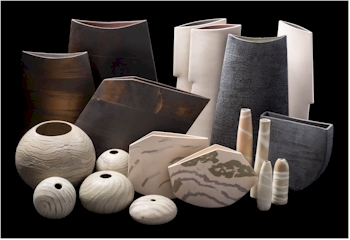
Selected items from the studio of Valerie Barry.
Fame can be a fickle mistress: there is an overused adage that today's news is tomorrow's chip paper. Likewise, the art world can also oversee a similar fall from recognition and such seems to be the case with Valerie Barry. Certainly in the 1970s and 1980s, she was well received, evidenced by the fact that her work was purchased by many international museums, including the Victoria & Albert. In addition she was awarded a Gold Medal in the 1975 Florence International Ceramics Competition. As well as many solo exhibitions, she exhibited in Hong Kong with Bernard, David and Janet Leach, Katherine Playdell-Bouverie, Michael Cardew, Colin Pearson, Henry Hammond and John Maltby amongst others.
As a London-based potter, it would be easy to think of her as metropolitan elite. Her Crouch End neighbours considered her 'a tall thin eccentric who drove a small Continental car and bought Perrier by the crate', but nothing could be further from the truth.

Val Barry at the wheel.
Her journey as a craftsman potter was an unorthodox one. Born into a Barnsley mining family, she hoped to be a fashion designer, but instead was told to get a proper job in nursing, although she was allowed to attend night classes at Sheffield Art School. At the age of 29, she left nursing to get married, moved to the capital and discovered pots: "I was crossing the road to look at pots, even bad pots, pots were compulsive."
This compulsion led to a practical leap, enrolling at a small ceramics school in Kensington, she was introduced to the wheel and joyously found that she could just do it. This led to a foundation course at the Sir John Cass School where she threw pots four days a week whilst illicitly attending classes at the Royal College of Art.
In spite of a period of illness and initial rejections from the Craftsman Potters Association and the Crafts Council, recognition came in 1971 with a solo exhibition in Gallery 273, Queen Mary's College, when a comment from a visitor "that pot reminds me of the canals on Mars" led Val Barry to consider form rather than function. This, and the decision to give up the wheel, which after a decade was aggravating a back problem, led to a switch to slab building: "craft potters can survive in Britain now without destroying themselves on cups and saucers", she once told a friend.

A stoneware charger from her 1971 solo exhibition together with a page from her notebook.
The greatest influence over Val Barry's work was the 1978 CPA sponsored trip to China where she drew influence from, rather than mimicking, the Oriental aesthetic and from this came a range of vessels that looked like the sails of becalmed junks.

Val Barry stoneware sail vases.
An exhibition of Chinese jades also led to sword forms, tall narrow pieces with dynamically cut rims that not only had a blade-like appearance, but looked as if they had received a precision strike from steel. From this base came a series of flattened geometric forms, often with a discrete curve, primarily with muted colours, sparse brushwork or wax resist decoration. Produced in varying sizes and forms, they were meant to be seen in groups, the spaces between them being equally as important.
Val said: "ideas grow, forms simplify until at best, line and mass coalesce in sculptural unity" into a "seamless pocket of clay". Her pots exude a calm confidence born out of 'someone who has worked with clay until its properties and potential become an ally rather than a barrier'. One could be forgiven for thinking that she was trying to push an idea to the extremes of size and balance. Delightfully at the end of the cycle, she uses a copper manganese glaze as if to give the refined vessel a final golden accolade.

A selection of Val Barry sword forms.
So why has Val Barry become largely forgotten? It certainly wasn't a lack of demand from those who collected her pots. Part of the answer lies in a change of direction which, considering her passion for the sculptural and the use of metallic glazes, it is hardly surprising she chose to work with bronze.

Val Barry: a porcelain sentry vessel that made the transition to bronze.
A grant from the Crafts Council in 1984 allowed her to study bronze techniques and provided a seamless transfer of her ideas to this new medium resulting in a number of commissions. This new career culminated in the organisation of 'Feeling Through Form' - a 1986 exhibition of civic sculpture at the Barbican, which also included work by Elizabeth Frink (though Val 'the sculptor' was known by her married name Valerie Fox). Unfortunately, a costly legal battle with her foundry several years later led to her having to sell her London home and move to premature retirement in Teignmouth in 1997.
So there you have it - a successful artistic career that crucially occurred pre-Internet, together with a change of tack and unplanned retirement probably making Val Barry the best studio potter you've never heard of. She deserves to be far better known and I feel sure that in the current post-Leach environment, she ought to find reinvigorated favour, but please don't take my word for it - find out for yourselves when we offer the selected contents from her studio on Tuesday, 11th June 2019.
- Bearnes Hampton & Littlewood
- Val Barry
- Pottery
Val Barry: Probably the Best Potter You've Never Hear Of! was written on Friday, 12th April 2019.










